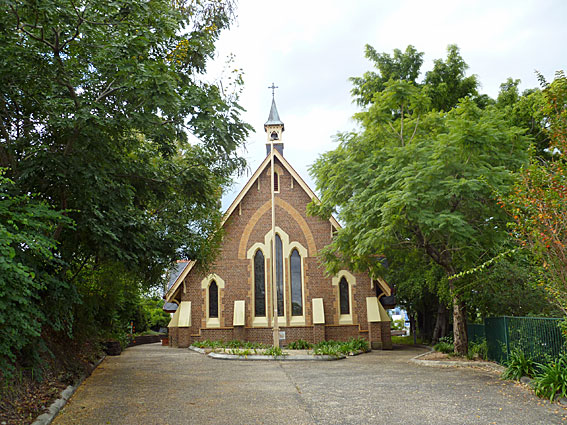
St Thomas' Anglican Church, Toowong
[Photograph by David Vann (May 2012)]

St Thomas' Anglican Church, Toowong
[Photograph by David Vann (May 2012)]
Historical and Technical Documentation by Geoffrey Cox1
© OHTA 2011, 2012, 2013, 2020 (last updated January 2020)
The present St Thomas' Church was opened in October 1877,2 replacing a timber building of 1865-66 on another site in the area. The congregation had been established first as an extension of All Saints' Parish, Wickham Terrace, but St Thomas' became an independent parish in 1870. Toowong grew rapidly following the introduction of the railway in 1875, and the foundation stone of the present church was laid in February 1877. Built of bi-chrome brick in the Early English Gothic style, the building was designed by the prominent Brisbane Colonial Architect, F.D.G. Stanley, who was a parishioner. The nave was extended in 1886 to Stanley's design, and the transepts and chancel were added in 1947, replacing a former temporary timber-framed structure.3
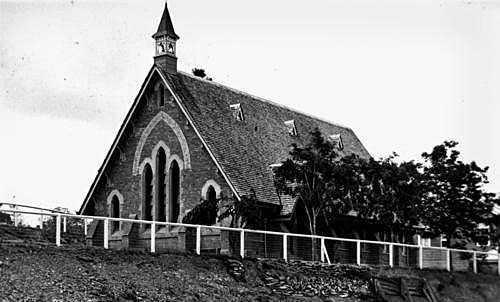
St Thomas' Anglican Church, Toowong (undated)
[Photograph: John Oxley Library, State Library of Queensland]
A report of the opening service in 1877 reveals that the organist was Walter Horatio Wilson, who was organist at this parish for twelve years.4 Wilson was later associated with the acquisition of organs at St Patrick's Church, Fortitude Valley, and the Presbyterian Church, Wickham Terrace. For the opening of the new church at Toowong in 1877, he had composed an anthem for the occasion:
The musical portion of this service was under the direction of the honorary organist, Mr. W. H. Wilson, assisted by the organist of All Saints, Brisbane (Mr. Lord), and was a credit to those concerned. The proper psalms for the occasion were well chanted by an efficient choir, and the anthem, composed by Mr. Wilson especially for the occasion to words selected from the 84th Psalm … was really well sung. We notice this composition elsewhere…5
Another account of the opening provides more details of Wilson's composition, and reveals in addition that a motet Cantate Domino by Mr Kaye was sung:
The opening and consecration services of this church were held on Saturday and Sunday last. Both services were largely attended, his Lordship the Bishop being present on each occasion. On Saturday … afternoon… the musical service which was admirably rendered by the choir, conducted by Mr. W. H. Wilson, the organist of the church, was a very interesting one. It included an anthem just composed by Mr. W. H. Wilson, which is, in our opinion, justly entitled to rank highly as a composition in church music. The words, which are from the 84th Psalm "O, how amiable are thy dwellings" were chosen by Archdeacon Glennie. The anthem opens with a full chorus, the phrase employed being melodious and free to sing. This is followed by a graceful unaccompanied quartet which is sung by four prominent members of the Musical Union in good style and with such correctness that on passing to the solo which immediately follows not a note was flat. The soprano solo "Blessed is the man whose strength is in Thee and in whose heart are Thy ways" is a sweet and pleasing aria... The anthem is brought to a conclusion by a full chorus on the words "Blessed are they that dwell in Thy House, they will be always praising Thee" written in the fugue style. … This was followed by a repetition of the first phrase for the chorus concluding with an "amen" by all the voices and the organ. … [On] Sunday morning, ... the anthem performed on Saturday was repeated, the Bishop preached the sermon which was on a text from the lesson of the day. In the evening, the musical service included another novelty – a Cantate Domino by Mr Kaye. This is also a promising composition and was well sung by the choir.6
The 'Mr Kaye' to whom reference is made above was almost certainly Samuel Kaye, who had been active previously in Melbourne as an organist and organ-builder. He formed a partnership in 1867 with David Lee as 'Lee & Kaye, importers of pianos, harmoniums and organs,' and the two were later joined by Robert Mackenzie in an organ-building partnership.7 Kaye appears to have moved to Brisbane around the mid 1870s. He was organist at St John's Pro-Cathedral, Brisbane, for a time in 1878.8 Describing himself as a 'piano and organ warehouseman,' he established a business partnership in Brisbane as 'Paling, Kaye & Jefferies' in 1876. The partnership dissolved in February 1881, and Kaye set up business on his own account soon afterwards.9
It was not until August 1888 that St Thomas' Church acquired a pipe organ, the opening of which was advertised as follows:
ST. THOMAS'S CHURCH, TOOWONG.
The NEW ORGAN will be opened TO-MORROW (Sunday), 19th August. Services, 11 a.m. and 7.30 p.m.
Mrs. OHMAN (late pupil of Mrs. W. G. Willmore) will preside at the organ.10
On the day following the opening of the organ, The Brisbane Courier provided further information about the instrument, indicating that it had been built by Mr B.B. Whitehouse, and was installed at Toowong by Mr [Edward] F. Waldron:
The organ built by Mr. Whitehouse which was recently purchased for St. Thomas's Church, Toowong, was brought into use for the first time at the services held in that church yesterday morning. There was nothing special in the service except that Mrs. Ohman, who is a pupil of Mrs. W. G. Willmore and was formerly organist at St. Andrews, South Brisbane, presided at the instrument and at the conclusion played a processional march in a manner that reflected great credit on both herself and teacher. The instrument was re-erected in the church by Mr. F. Waldron, who has replaced the original springs by new ones and will shortly make other improvements, the chief of which will be to bring down the open diapason, which at present stops at the tenor C, through to the double C. The sermon was preached by the incumbent, the Rev C. W. Healbrook, M.A., from Matthew viii, 19. There was a large congregation and many remained to listen to the processional march.11
The interior of St Thomas' Church, Toowong
showing the B.B. Whitehouse organ installed in 1888
[Photograph (before the addition of transepts and chancel in 1947)
from the Anglican Diocese of Brisbane
Records and Archive Centre, TOOWS 141 – Box 8]
The instrument installed at St Thomas' Church in 1888, however, was not entirely 'new'. It had been completed more than two years earlier, in late April or early May 1886, when it was much vaunted in The Brisbane Courier as the first organ 'entirely built' in Brisbane:
It is always pleasant to be able to chronicle the establishment of a new industry in Brisbane, and the other day we inspected a specimen of colonial manufacture, which, as a fore-shadowing of what may in the future grow to be an important branch of local industry, is deserving of more than a passing mention. At the Queensland Music Warehouse there is now on view a church organ, which, though not the first put together in Brisbane, is the first which has been entirely built here, and the first the fittings and various parts of which have been entirely made in Brisbane by Brisbane artisans. The organ, designed by Mr. Young, has been built, under his supervision, by Mr. Whitehouse, the head tuner and repairer to the firm, upon their premises in Queen-street, and contains nine stops upon cathedral scale, and wind pressure, three composition pedals, a swell, and a grand pedal bourdon. Space has been left for the addition of another reed or flute stop, should the purchasers desire it. The case will not be completed, nor will the usual ornamental pipes, &c, in the front be added, until ordered. The present front, so far as completed, is formed of Queensland pine and cedar, arranged in beautifully polished panels of picked specimens of these timbers. The stops consist of bourdon, open diapason, flute, dulciana, stop diapason, claribella, principal, fifteenth, and coupler. The pedal bourdon is 16ft pitch; open diapason, metal, 8ft; flute, wood, 8ft; claribella, wood, 8ft.; dulciana, metal, 8ft.; &c There is but one manual. At a trial performance the other day we had an opportunity of judging of the power and tone of the new instrument. The open diapason gave a splendid effect, equal to that of many an organ twice the size, and the dulciana was also found to be of very beautiful quality in tone. The swell was not quite completed at the time, but even in its incomplete state, promised well. The selling price, case included, is £300, a much smaller sum than [a] similar instrument would have cost if imported. There is, therefore, reason to hope, as it has now been demonstrated satisfactorily that organ building can be carried out in Brisbane so as to compete successfully in price and quality with the home manufactories that before many years shall have elapsed we may see not only organs but pianos manufactured in this colony. The skilled labour could be easily obtained, and many of our Queensland woods would be admirably adapted for the making of piano cases. The instrument under notice reflects the greatest credit on all concerned in its construction: and all the ironwork and fittings have been made in Brisbane by local workmen.12
The instrument was advertised for sale early in May 1886:
FOR SALE.
THE NEW ORGAN,
Built by the QUEENSLAND PIANO. ORGAN, AND MUSIC
WAREHOUSE COMPANY,
JOHN YOUNG, MANAGER,
141 Queen-street, Brisbane.
Inspection Invited.13
The organ appears to have languished on the showroom floor for a good two years before being purchased in August 1888 for St Thomas' Church. It was again described at this time as the 'first organ built in this colony':
Some time ago a description was given of the first organ built in this colony. The instrument, which was made by Mr. Whitehouse, of the Queensland Piano and Organ Company, from designs furnished by Mr. John Young, has just been bought from Mr. L. Flegeltaub for St. Thomas's Church of England, Toowong. The organ was valued by the makers at £300, but it has been obtained by the church for a good deal less than that sum, on account of the winding up of the company's business.14
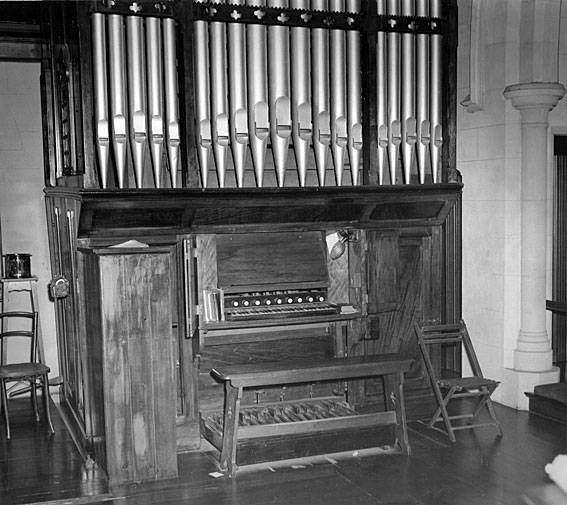
The B.B. Whitehouse organ at St Thomas' Church, Toowong
[Photograph (before 1963) from the Anglican Diocese of Brisbane
Records and Archive Centre, TOOWS 141 – Box 8]
Benjamin B. Whitehouse had emigrated from England to Queensland in 1883.15 He is recorded as installing organs in St Paul's Anglican Church Maryborough and the Wesleyan Church, Maryborough as early as March 1884, and he worked during these early years for the Queensland Piano, Organ and Music Warehouse Company, 141 Queen Street, Brisbane, of which Mr John Young was the manager. John Young's firm appears to have ceased operation around the middle of July 1888, and the above report suggests that the organ became the property in the interim of Mr. L. Flegeltaub, who was the manager of Goldsmiths' Hall Company, Watchmakers and Manufacturing Jewellers, Queen Street.16
The instrument was of modest size, comprising one manual and pedals. The specification, recorded many years later, suggests that Waldron did not carry out the proposed addition of a bottom octave to the Open Diapason:
| MANUAL Open Diapason Stopped Diapason Clarabel Dulciana Principal Fifteenth Oboe PEDAL Bourdon COUPLER Manual to Pedal |
8 8 8 8 4 2 8 16 |
[Tenor C] [Bass] [Tenor C] [Tenor C] |
Mechanical action
Trigger swell pedal (2 positions)
Pedalboard: straight & concave
Compass: [56/30]
3 composition pedals.17
Despite the claims made concerning this instrument, it appears neither to have been 'the first organ built' in the colony, nor to have been 'entirely built' in Queensland. The distinction of being the first organ built in Queensland appears to belong to the instrument built by Thomas C. Christmas around 1881 for W.H. Wilson, and installed in 1882 at St Patrick's Catholic Church, Fortitude Valley. Christmas's instrument was said to have been 'built almost entirely' by him, and the same might be said of the B.B. Whitehouse instrument of 1886, which can be shown to have incorporated a substantial amount of material manufactured in Melbourne by George Fincham.
B.B. Whitehouse may well have made the Pedal Bourdon pipes, the windchests, casework and action, but the Letter Books of George Fincham reveal that most of the other components were supplied directly from Melbourne to John Young. These included the pipes for all of the manual stops (pre-voiced), keyboards, rackpins, tapped wires, drawstops, conveyances and other parts ordered and sent in 1885. An oboe stop, front pipes, dummy pipes and draw stops were supplied in 1886.18
Substantial work of an unspecified nature was undertaken by Whitehouse Bros of Brisbane in January 1923, when expenditure of £61.15.0 was recorded.19 The organ was dismantled, re-erected and reconditioned by Whitehouse Bros in December 1948, at which time tubular-pneumatic action was applied to the Pedal Bourdon stop.20 The reference to 'dismantling and re-erecting' was presumably associated with the addition of the chancel and transepts to the building at this time.
Little, if any, of B.B. Whitehouse's work now remains. The organ was completely rebuilt with electric action and enlarged in 1963 by H.W. Jarrott of Brisbane. All of the original manual pipework (which had been supplied by Fincham) was retained, but the old Pedal Bourdon 16ft was replaced.
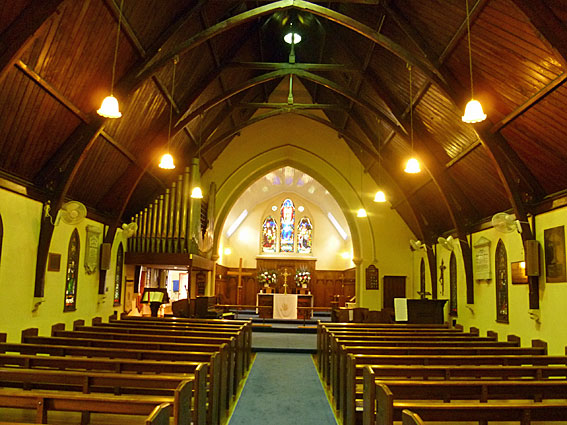

The present church interior, showing the organ
as rebuilt and enlarged in 1963 by H.W. Jarrott
[Photographs by David Vann (May 2012)]
The specification since 1963 has been is as follows:
| GREAT Open Diapason Dulciana Flute Fifteenth SWELL Violin Diapason Claribel Echo Gamba Principal Oboe PEDAL Bourdon Bass Flute COUPLERS Swell to Great Great to Pedal Swell to Pedal Swell Sub Swell Super Swell Unison Off Swell Sub to Great Swell Super to Great |
8 8 4 2 8 8 8 4 8 16 8 |
[1886; new bass 1963] [1886; new bass 1963] [1963] [1886] [1963] [1886] [1963] [1886] [1886] [1963] [1963] |
Tremulant
Direct electric action
Detached stop-key concole
Compass: 61/30
Pedalboard: radiating & concave
3 pistons to Great Organ
3 pistons to Swell Organ
Balanced swell pedal.21
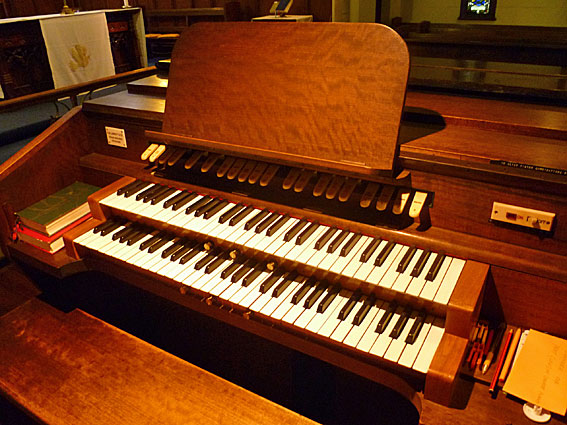
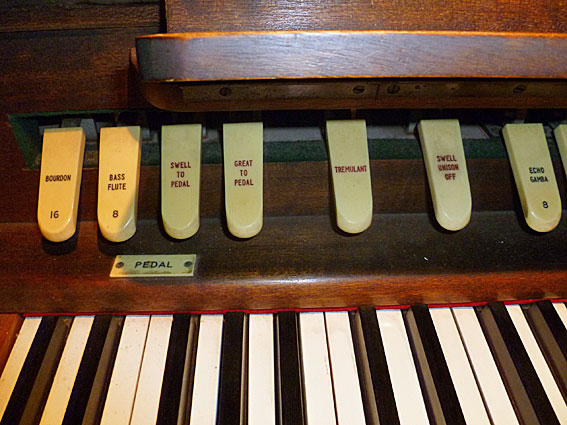
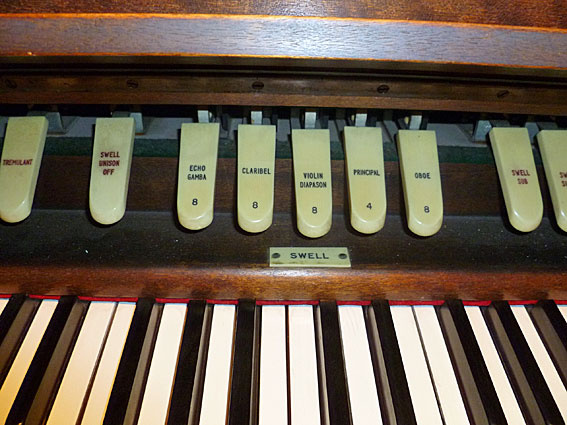
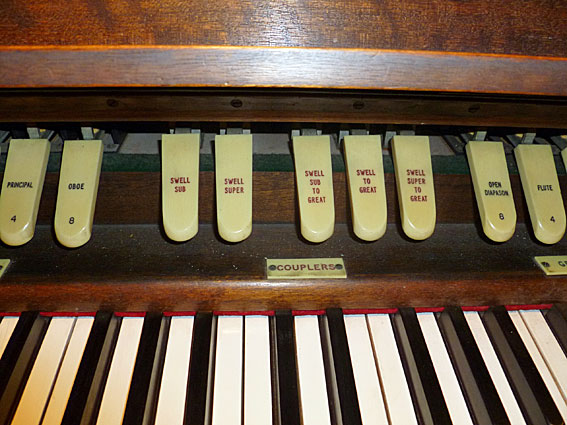
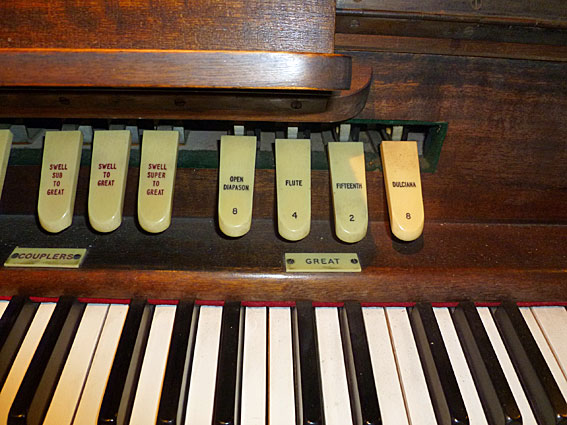
The Jarrott console of 1963, and stop-tab details
[Photographs by David Vann (May 2012)]
Substantial alterations to the instrument were made in January-February 2019 by Doug Milne (tuning and maintenance ) and Graham Hyde (Assistant Organist), including the following:
• removal of pipes from Swell;
• removal and cleaning of rackboards and soundboards;
• painting of Swell Box interior with Polyurethane;
• cleaning of pipes, re-installation of rackboards with minor repairs;
• re-felting of stoppers on Claribel, and installation of pipes; provision of brass tuning slides for the top 5(metal) pipes;
• re-installation of Echo Gamba, with adjustments to holes in rackboards – filing larger or felting where needed;
• cutting of hole in front of Swell Box, and provision of access panel for tuning bottom Oboe pipes;
• freeing of caps on Violin Diapason; opening hole in rackboard to allow pipes to seat properly on soundboard; refitting of Violin Diapason rank;
• changing of Principal rank to slide tuning,
• cleaning and straightening of Oboe pipes; including polishing of shallots and reeds,
• changing Fifteenth rank to slide tuning,
• Removal of all but show pipes from Great; cleaning of pipes; removal of rackboards except for Open Diapason at front; cleaning of rackboards and soundboards and re-installation; gilding of small Diapason show pipes;
• Fitting of tuning slides to Great Diapason pipes (formerly cone tuned);
• fitting Dulciana pipes with tuning slides as needed; opening of damaged toe holes and re-installation;
• fitting of tuning slides to Great Flute pipes (formerly cone-tuned) and re-installation;
• removal of Bass Flute pipes; cleaning, checking of caps and re-installation;
• provision of protective rail for Great Fifteenth, Swell Echo Gamba and Pedal Bass Flute;
• provision of support for large Dulciana pipes;
• tuning of organ.22
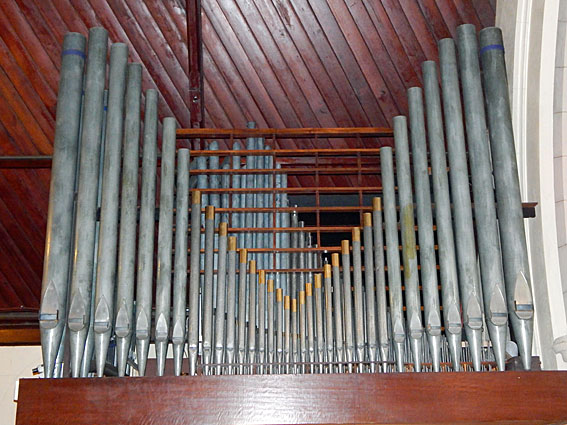
Open Diapason façade pipes, cleaned and lacquered
with gold tuning slides
[Photograph by Doug Milne (July 2019)]
___________________________________________________________
1 An earlier version of the historical documentation presented here with regard to the B.B. Whitehouse organ of 1886 appeared in 2011 as: Geoffrey Cox, 'B.B. Whitehouse and the First Organ Built in Queensland,' OHTA News, vol. 35, no. 1 (January 2011), pp. 19-24.
2 'Diary of Events' for 13 October 1877 in Pugh's Queensland Almanac . . . for 1878.
3 Queensland Heritage Council, Queensland Heritage Register, location 600336.
4 J.C.H. Gill, 'Wilson, Walter Horatio (1839-1902),' Australian Dictionary of Biography, Vol. 12 (Melbourne University Press, 1990), p. 531. Online version at http://adbonline.anu.edu.au/biogs/A120597b.htm - accessed March 2011.
5 The Brisbane Courier (15 October 1877), p. 3.
6 The Week (20 October 1877) – cited in Helen Gregory, A Church for its Times: The Story of St. Thomas' Church, Toowong (Toowong, 1977), pp. 15-16.
7 Enid Matthews, Colonial Organs and Organ Builders (Carlton: Melbourne University Press, 1969), pp. 27, 79.
8 Robert K. Boughen, 'An Account of the Music at St John's Cathedral, Brisbane, from 1843-1887,' M.Mus. qual. thesis, University of Queensland, 1974.
9 W. Frederic Morrison, The Aldine History of Queensland (Sydney: Aldine, 1888), vol. 2, appendix, p. 218.
10 The Brisbane Courier (18 August 1888), pp. 1, 5.
11 The Brisbane Courier (Monday 20 August 1888), p. 4.
12 The Brisbane Courier (24 April 1886), p. 4; and The Queenslander (8 May 1886), p. 740.
13 The Brisbane Courier (8 May 1886), p. 8. & (10 May 1886), p. 1.
14 The Brisbane Courier (18 August 1888), p. 6.
15 Graeme Rushworth, Historic Organs of New South Wales: The Instruments, Their Makers and Players, 1791-1940 (Sydney: Hale & Iremonger, 1988), p. 203.
16 Cox, op. cit., pp. 19-20.
17 Collected Organ Specifications of Bernie Brohan (c.1952) & Notebooks of Mr. E.R. Salisbury. Compass noted from the photograph above.
18 George Fincham Letter Book 4, pp. 200, 230, 367 (1885) and Letter Book 5, pp. 37, 67 (1886) – cited by E.N. Matthews in Fincham/Matthews Collection (State Library of Victoria, MS 9423). Further details are given in Cox, op. cit., pp. 22-23.
19 Whitehouse Bros Ledger (1922-1940), p. 117.
20 Whitehouse Bros Ledger (1940-1954), p. 486.
21 Specification supplied to G. Cox by Mrs Ruby Knight, organist, March 1974; details of rebuild supplied to G. Cox by H.W. Jarrott, c.1974.